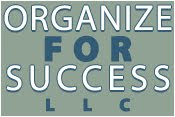Each day, we are faced with an onslaught of information. Much of that information avalanche comes from email, and there are solutions specific to controlling your email instead of letting email control you. Yet, there is an equally pressing need to address the overwhelm from paper and electronic documents. Follow these steps for relief in accessing knowledge via paper and electronic sources.
- Limit what you retain. Whenever you have to dig through more files to find whats needed, it takes longer. Make friends with delete and discard, keeping only what is accurate, applicable, useful, bringing you joy as well as difficult to replicate or find online. Then, schedule time to maintain this system, continually evaluating what comes into your space while addressing your retention cycle so things are not kept longer than needed.
- Convert what paper you can to an electronic format. It is easier to find content needed in electronic form. Further, filling electronic storage space creates fewer pains and often takes longer to reach existing limits. To reach this goal, choose from physical scanners, like Doxie or Fujitsu, install the Scannable app on your iPhone or CamScanner app on your Android device and partner with scanning companies to help catchup on your backlog, like The File Depot or Shoeboxed, culling together in your preferred option.
- Control the funnel into your space. When left up to the person delivering paper to your office, each will be piled atop the last on your desk or bureau; however, once something gets stacked on top of something else, you no longer know what is below. Counter that situation by hanging an inbox (and, ideally, an outbox) near the door to your workspace, whether a Three by Three Wall Pocket, reisenthel Clear Wall Pockets, a Rustic Marche Wall Pocket, a Yamazaki Nest 2-Pocket Wall Organizer or something similar. Tools like an inbox and outbox empower you to address what's most important when it's convenient for you and separate those items from what is currently being handled atop your desk.
- Implement naming conventions. If you can mirror names between email mailboxes, paper files and electronic document folders, it will be easier to know what you have, put things where they belong and, then, recover what's needed quickly. There is no "right" or "wrong" verbiage for labeling, although I discourage using "miscellaneous" since that is non-descriptive; however, there is an art to creating a filing system... You want enough folders so everything has a home but not so many options that any one item could realistically be filed in more than one place. Balance carefully between generic and specific so each email, paper or electronic file has a clear destination that is easy to maintain. The worst scenario is to struggle in determining where something should be kept as it means you'll struggle even more when looking to retrieve it later.
How do you choose what papers and electronic files to keep? What system do you use for successfully retaining them? Or how do you struggle with your documents?
Friday, January 19, 2018
Organize Your Files to Quickly Find What's Needed
Subscribe to:
Post Comments (Atom)


No comments:
Post a Comment